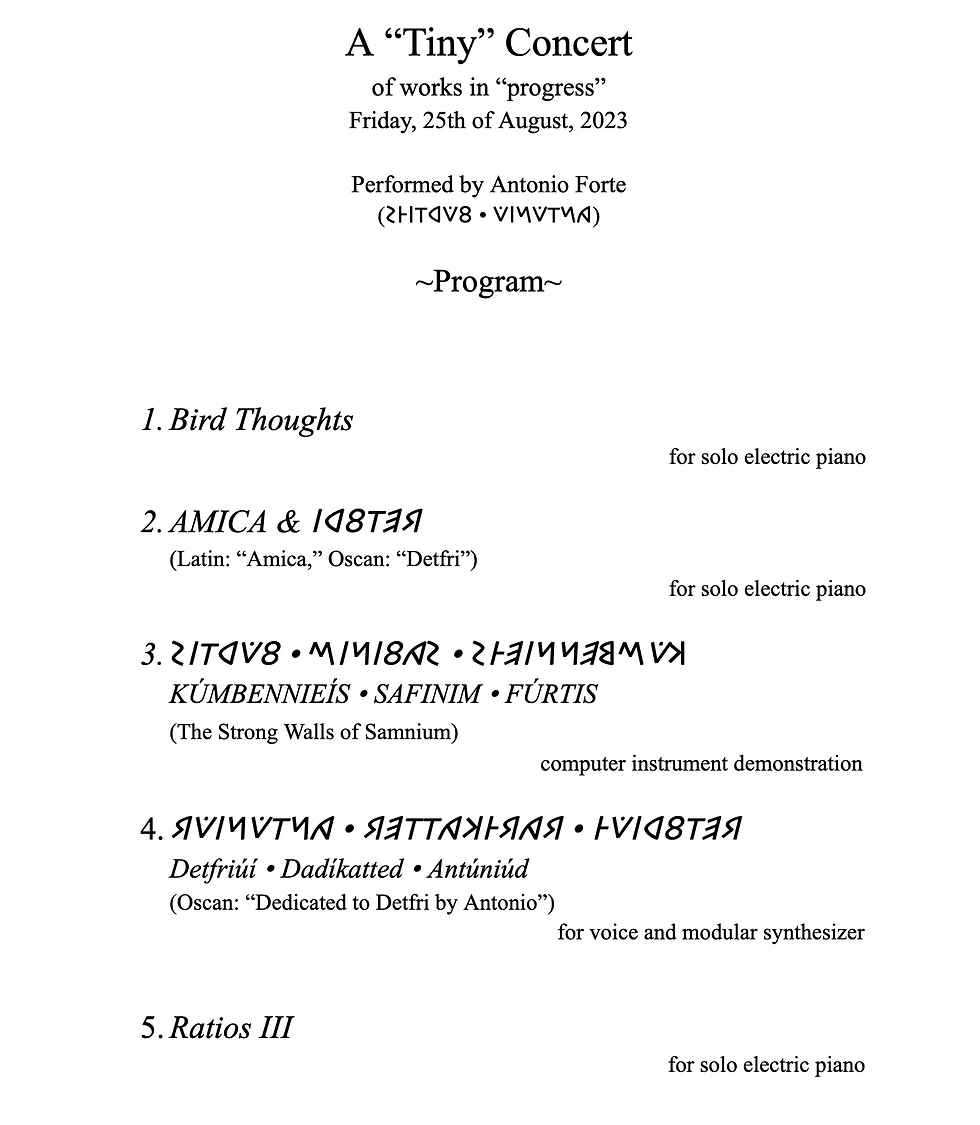I Suoni delle Pietre.
- Antonio Forte
- Sep 10, 2023
- 3 min read
Updated: Sep 14, 2023
The sounds of the stones. In an effort to hear what the many hours of tracing and puzzling would glean, without the presence of actual string instruments, I turned to my trusty companion: the processing and GUI (graphical user interface) software MAX/MSP. Using MAX I patched together a prototype interactive computer instrument to allow me to listen to each of the musical polygons, on their own or alongside each other. I presented this computer instrument at my next "tiny" concert in the Museum's library.
To 'play' this instrument, one first selects a tempo by typing in a number in the 'tempo' box. This is measured in milliseconds. Then the instrument is toggled on or off with the grey box with the X. Finally, one clicks on each stone's number to activate its melody. Additionally, the user must first load the background, by clicking on 'read' and selecting the appropriate file which is a JPEG of the photograph of the Samnite polygonal stone wall. The title of this instrument takes its name from the title of the eventual musical composition (see previous blog post). It is pronounced: KÚMBENNIEÍS SAFINIM FÚRTIS.
A short video demonstration is below.
The sounds used for this computer instrument were synthesized from dual sine and triangle wave oscillators within the MAX patch. I created a crossfader that morphs the waveform smoothly between sine and triangle wave shapes, the frequency of which is controlled via an adaptive LFO (low frequency oscillator) of my own making. In short, the 'knob' which fades between sine and triangle is automated by another waveform, which changes its own frequency randomly at the end of each cycle. The randomness of these changes creates its own pseudo-organic sound. In my experience of working with hardware and software synthesis, when it comes to sequencing it is easy for something to sound repetitive, and thus uninteresting; whereas, while the sequence of pitches may be the same over and over again, by varying the timbre or tone color of the notes, one creates a sense of change, and therefore, perhaps, interest. Further tonal complexity was added by using my adaptive LFO to control the duty cycle of the triangle wave, morphing it smoothly (at random frequencies) between ramp wave, triangle wave, and sawtooth wave.
To add even more complexity to the oscillators, and to provide articulation to the individual notes as they occur, I inserted a low-pass gate instead of simply using a controllable amplifier (or volume knob). A low-pass gate is a combination amplifier and low-pass filter, which means that the opening and closing of the amplitude (turning the volume up/down or on/off) also affects the harmonic content of the oscillators. This adds additional timbral complexity, as well as a particular 'ping' to the start of each note, something that is a well-known, perhaps stereotypical, sonic signature of low-pass gates. The low-pass gate is a quintessential element of Buchla hardware synthesizers. There is also a bit of digital reverb added at the very end of the entire audio signal chain, just so it does not all sound so 'dry.'

[Caption: The 'innards' of my MAX patch. This is the dual oscillator of my own design, crossfading between sine and triangle waves. You can see the combination of waves being visualized in the dark grey windows, which are oscilloscopes. The sine wave (left box) and triangle-turned-sawtooth wave (right box) are combined to form a complex waveform (bottom box).]
I see this computer instrument first and foremost as a means by which an idea could be workshopped and prototyped; as I wrote above, to hear what the stones sound like without having access to a string quartet. However, as things usually are wont to do when I use MAX/MSP, a certain 'life-of-its-own' has presented itself. The possibilities of using it as its own stand-alone instrument are indeed intriguing, and I enjoy the interactive nature of both its interface and the photograph. There are still some 'bugs' in the system to work out (i.e. audio distortions probably due to gain staging, etc.), but I am keen to begin creating a few recordings of it on its own, and to release it into the wild to allow other folks to create with it.

[Caption: Program from another "Tiny" concert in the Museum's library, in which this instrument was demonstrated.]
Stay tuned for the next post. Standing in wet clay.



I love love love this! What a great sound you have created - am looking forward to talking to you more about this (and having you talk to my students about it too!!!) BRAVO!!!